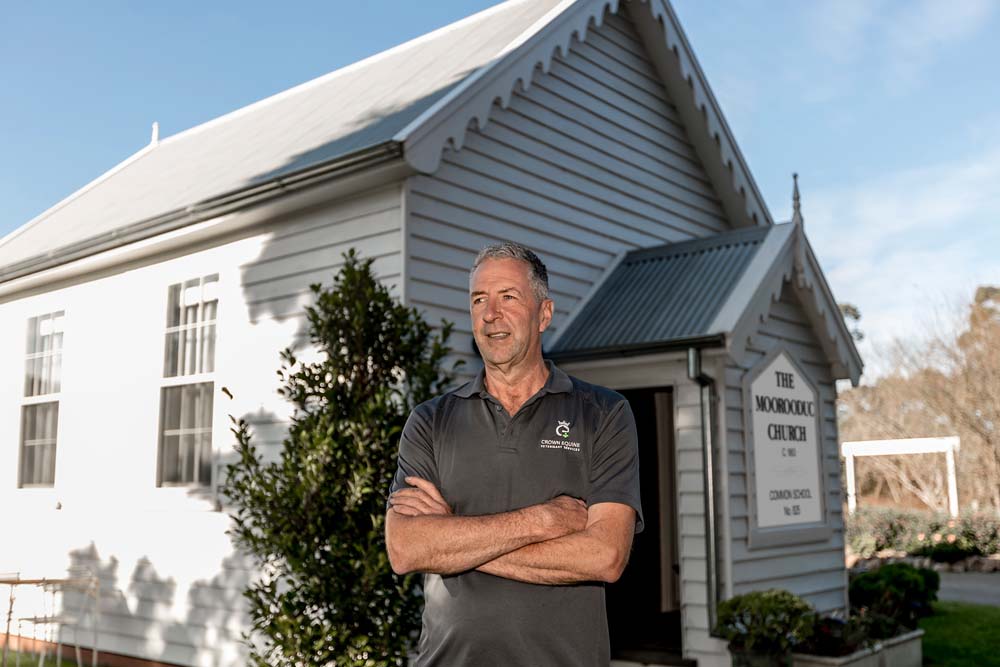By Cameron McCullough Photos Yanni
It has been a project of meticulous work and attention to detail, but Mornington Peninsula builder Stephen Foster has put the finishing touches to the restoration of a piece of history.
The church in Moorooduc, built bu the Presbyterians in 1863, has been restored to its former glory.
“There would only be a few buildings older than this on the whole of the peninsula,” said Stephen.
“It was sold off and locked up nearly 20 years ago. But before that, it used to be an integral part of Moorooduc’s history, serving not only as a church, but the township’s first school.
“There are a lot of people who have lived in the area all their lives, that had parents who got married in this church or they got christened here, so it’s a really important thing to the people.”
After it was sold off, no maintenance was done on the old church and it fell into a state of disrepair.
Fate intervened in January, 2016, when Stephen and his wife Pam spotted the church for sale on the internet.
“We instantly fell in love with it, and purchased it straight away,” said Stephen.
“We knew it would be a huge task to bring it back from its dilapidated state, but we started drawing up plans to restore it and working with council to get our vision approved”.
Stephen and Pam envisaged restoring the original church for use as a bed and breakfast and living on the land to take care of it. They submitted plans to council to be able to build a dwelling at the rear of the church to enable them to protect the original building from vandalism.
“That planning process took us 18 months, and luckily the council was good enough to see the value in preserving the heritage aspect of the building. It was a long process, but the council saw the benefit of saving the building,” Mr Foster said.
Once approved, the real work began.
Not only did the Fosters begin building their private dwelling at the back of the property, but they had to begin the painstaking process of restoration of the old church.
“We began by sourcing materials that we would need,” said Stephen.
“We sourced from all over the state. Anything we thought was from the correct period to do justice to an historical building from 1863. That process was one that took several years”.
When it came time to begin work on the church, great care had to be taken, and close attention paid to detail to bring it back to its former state.
“It wasn’t just a matter of slapping a new coat of paint on. That was not our vision. This had to be done perfectly, with all the time and love it required”, said Stephen.
The entire structure was jacked up and completely restumped, all the joists and bearers were repaired, the frame was repaired, the flooring was replaced, and even the roof was removed and reset.
“This was not your average building job,” said Stephen.
“We removed every single weatherboard, one at a time, repaired them and then replaced them. We removed the windows and engaged a joiner to replicate the original mouldings. We knew what we wanted, and we were not willing to compromise”.
It was a task that required considerable patience, and an eye for detail; always respecting the original building but transforming it into something that was usable now and into the future.
“The original church didn’t have a kitchen or bathroom, and we knew we needed to introduce these features to make it functional as a bed and breakfast,” said Stephen.
“Our approach was to introduce these things with respect and consideration to the original structure, almost giving the impression they were always there.
“While we had to balance practicality with historical value, we were able to say to ourselves “if the original building had a kitchen, what would it have looked like?’”.
Stephen sought to preserve as much of the original building as possible, such as reusing the original floorboards to make a front door for the church.
“It adds a lovely touch to the building and preserves history, albeit in a different form from the original use as floorboards”.
When it came to the internal design of the church, Stephen spared no expense in pursuit of perfection.
“We used a lot of modern techniques and modern products to achieve a luxurious but traditional look,” said Stephen.
“We were fortunate enough to have interior designer Mardi Mason come in to assist us with our interior and finishings.
“We are very happy with the outcome that gives a strong nod to tradition while keeping it practical and appealing.”
And as for the legacy of bringing one of the peninsula’s oldest buildings back from the brink?
“We are really proud of what we have achieved here,” said Stephen.
“We hope that in a hundred years, we will have become a part of this church’s story. There is nothing better than maintaining the legacy of one of the peninsula’s oldest buildings through writing yourself into its rich history.”
The Moorooduc Church is now taking bed and breakfast bookings for when the industry opens post Covid-19. Stephen sees busy times ahead as restrictions on travel mean Victorians may need to holiday closer to home.
“We sincerely hope the public will get a chance to enjoy the church one again,” said Stephen.
“It really is at the gateway to the peninsula; only five kilometres from Mornington’s beaches, and with everything else our wonderful part of the world offers on its doorstep.”

